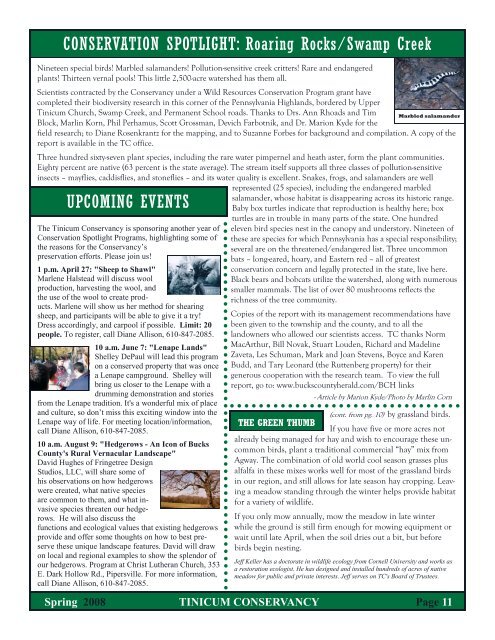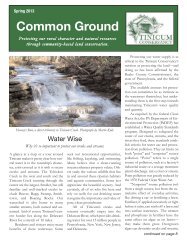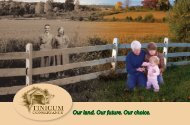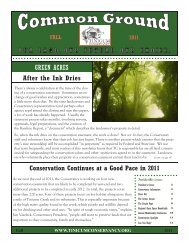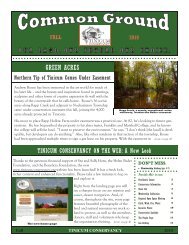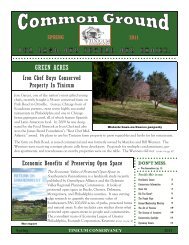Newsletter-Spring '08-FINAL to printer3-6-08 - Tinicum Conservancy
Newsletter-Spring '08-FINAL to printer3-6-08 - Tinicum Conservancy
Newsletter-Spring '08-FINAL to printer3-6-08 - Tinicum Conservancy
Create successful ePaper yourself
Turn your PDF publications into a flip-book with our unique Google optimized e-Paper software.
CONSERVATION SPOTLIGHT: Roaring Rocks/Swamp CreekNineteen special birds! Marbled salamanders! Pollution-sensitive creek critters! Rare and endangeredplants! Thirteen vernal pools! This little 2,500-acre watershed has them all.Scientists contracted by the <strong>Conservancy</strong> under a Wild Resources Conservation Program grant havecompleted their biodiversity research in this corner of the Pennsylvania Highlands, bordered by Upper<strong>Tinicum</strong> Church, Swamp Creek, and Permanent School roads. Thanks <strong>to</strong> Drs. Ann Rhoads and TimBlock, Marlin Korn, Phil Perhamus, Scott Grossman, Devich Farbotnik, and Dr. Marion Kyde for thefield research; <strong>to</strong> Diane Rosenkrantz for the mapping, and <strong>to</strong> Suzanne Forbes for background and compilation. A copy of thereport is available in the TC office.Three hundred sixty-seven plant species, including the rare water pimpernel and heath aster, form the plant communities.Eighty percent are native (63 percent is the state average). The stream itself supports all three classes of pollution-sensitiveinsects – mayflies, caddisflies, and s<strong>to</strong>neflies – and its water quality is excellent. Snakes, frogs, and salamanders are wellrepresented (25 species), including the endangered marbledUPCOMING EVENTSThe <strong>Tinicum</strong> <strong>Conservancy</strong> is sponsoring another year ofConservation Spotlight Programs, highlighting some ofthe reasons for the <strong>Conservancy</strong>’spreservation efforts. Please join us!1 p.m. April 27: "Sheep <strong>to</strong> Shawl"Marlene Halstead will discuss woolproduction, harvesting the wool, andthe use of the wool <strong>to</strong> create products.Marlene will show us her method for shearingsheep, and participants will be able <strong>to</strong> give it a try!Dress accordingly, and carpool if possible. Limit: 20people. To register, call Diane Allison, 610-847-2<strong>08</strong>5.10 a.m. June 7: "Lenape Lands"Shelley DePaul will lead this programon a conserved property that was oncea Lenape campground. Shelley willbring us closer <strong>to</strong> the Lenape with adrumming demonstration and s<strong>to</strong>riesfrom the Lenape tradition. It's a wonderful mix of placeand culture, so don’t miss this exciting window in<strong>to</strong> theLenape way of life. For meeting location/information,call Diane Allison, 610-847-2<strong>08</strong>5.10 a.m. August 9: "Hedgerows - An Icon of BucksCounty's Rural Vernacular Landscape"David Hughes of Fringetree DesignStudios, LLC, will share some ofhis observations on how hedgerowswere created, what native speciesare common <strong>to</strong> them, and what invasivespecies threaten our hedgerows.He will also discuss thefunctions and ecological values that existing hedgerowsprovide and offer some thoughts on how <strong>to</strong> best preservethese unique landscape features. David will drawon local and regional examples <strong>to</strong> show the splendor ofour hedgerows. Program at Christ Lutheran Church, 353E. Dark Hollow Rd., Pipersville. For more information,call Diane Allison, 610-847-2<strong>08</strong>5.Marbled salamandersalamander, whose habitat is disappearing across its his<strong>to</strong>ric range.Baby box turtles indicate that reproduction is healthy here; boxturtles are in trouble in many parts of the state. One hundredeleven bird species nest in the canopy and unders<strong>to</strong>ry. Nineteen ofthese are species for which Pennsylvania has a special responsibility;several are on the threatened/endangered list. Three uncommonbats – long-eared, hoary, and Eastern red – all of greatestconservation concern and legally protected in the state, live here.Black bears and bobcats utilize the watershed, along with numeroussmaller mammals. The list of over 80 mushrooms reflects therichness of the tree community.Copies of the report with its management recommendations havebeen given <strong>to</strong> the <strong>to</strong>wnship and the county, and <strong>to</strong> all thelandowners who allowed our scientists access. TC thanks NormMacArthur, Bill Novak, Stuart Louden, Richard and MadelineZaveta, Les Schuman, Mark and Joan Stevens, Boyce and KarenBudd, and Tary Leonard (the Ruttenberg property) for theirgenerous cooperation with the research team. To view the fullreport, go <strong>to</strong>: www.buckscountyherald.com/BCH links- Article by Marion Kyde/Pho<strong>to</strong> by Marlin Corn(cont. from pg. 10) by grassland birds.THE GREEN THUMBIf you have five or more acres notalready being managed for hay and wish <strong>to</strong> encourage these uncommonbirds, plant a traditional commercial “hay” mix fromAgway. The combination of old world cool season grasses plusalfalfa in these mixes works well for most of the grassland birdsin our region, and still allows for late season hay cropping. Leavinga meadow standing through the winter helps provide habitatfor a variety of wildlife.If you only mow annually, mow the meadow in late winterwhile the ground is still firm enough for mowing equipment orwait until late April, when the soil dries out a bit, but beforebirds begin nesting.Jeff Keller has a doc<strong>to</strong>rate in wildlife ecology from Cornell University and works asa res<strong>to</strong>ration ecologist. He has designed and installed hundreds of acres of nativemeadow for public and private interests. Jeff serves on TC's Board of Trustees.<strong>Spring</strong> 20<strong>08</strong> TINICUM CONSERVANCY Page 11


